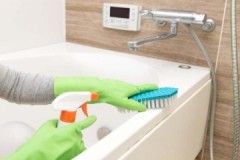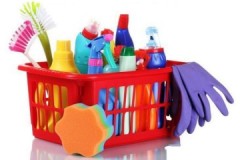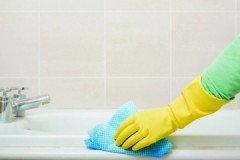Methods of struggle, or how to clean limescale in the bathroom at home
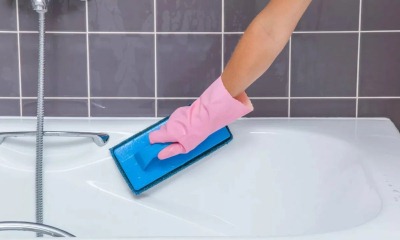 Water with a high concentration of potassium and magnesium salts gives housewives a lot of trouble. It dries the skin, increases the consumption of detergents, forms a sludge that is deposited on the walls of the pipes, and disables heating elements.
Water with a high concentration of potassium and magnesium salts gives housewives a lot of trouble. It dries the skin, increases the consumption of detergents, forms a sludge that is deposited on the walls of the pipes, and disables heating elements.
The bath becomes covered with limescale during contact with such water. In the fight against it, there is not enough soap solution and a rag.
How to clean the limescale in the bathroom at home, we will tell you in the article.
Content
How to remove folk remedies?
You don't have to buy expensive concentrates and sprays to remove limescale. You can find effective remedies in your kitchen or medicine cabinet.
Vinegar
Table vinegar (9% solution) copes with plaque, removes pollution of any nature and complexity, fungus, mold. Used for disinfection.
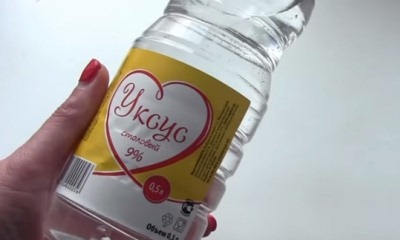 Mode of application:
Mode of application:
- Mix water and vinegar in a 1: 1 ratio.
- Apply to surface with a sponge or spray bottle.
- Leave it on for 15-20 minutes.
- Wash off with clean cool water.
The product works well when paired with soda or citric acid. Powdered components are mixed with water until a slurry is formed, applied to a bowl, a vinegar solution is sprayed on top, and then washed off.
A thick layer of plaque breaks down more slowly, so some housewives use vinegar essence. When working with the liquid, remember about its high concentration and personal safety measures.
How to wash off limescale in the bathroom with vinegar, video instruction:
Soda
A universal cleaning agent that can be used on almost all surfaces. To remove you need:
- add 2 tbsp. tablespoons of soda to 200 ml of liquid detergent;
- apply the solution to the bottom and walls of the bathroom;
- sponge;
- rinse thoroughly with running water.
Lemon acid
The product effectively fights plaque, has a pleasant smell, does not irritate the upper respiratory tract.
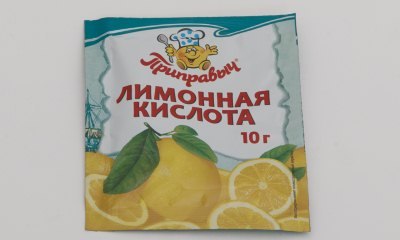 Mode of application:
Mode of application:
- Dissolve 1 tbsp.l of citric acid in 200 ml of water.
- Apply to the bowl with a soft sponge or spray bottle.
- Leave it on for 15-20 minutes.
- Sponge the surface.
- Wash off with running water.
Safe even for acrylic surfaces.
Ammonia
Ammonia will help remove plaque. This requires:
- 3 tbsp. dilute spoons of the product in 200 ml of water;
- distribute the liquid over the affected surface;
- leave for 10-15 minutes;
- wash off with clean water using a cloth or sponge.
To simultaneously remove rust, add 1 tbsp to the ammonia. l of industrial bleach in a 1: 1 ratio.
Salt
Crystals in dry form can leave damage on the surface, so they can be used only in dissolved form. To remove you need:
- 1 tbsp. Dissolve l of salt in 200 ml of warm vinegar (heat in a steam bath).
- Apply the solution to problem areas.
- Leave on for 20-30 minutes.
- Rinse off the softened plaque thoroughly.
How to remove with special compounds?
It is easier to choose ready-made concentrates and solutions of household chemicals, since the manufacturer indicates on the label for the surfaces from which material they are intended. The hostesses recommend:
-
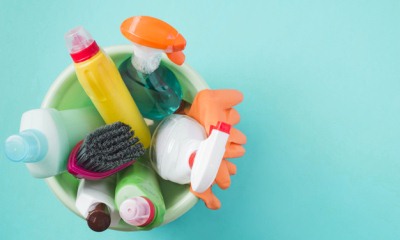 Bagi Akrylan - universal spray foam for baths made of any materials based on surfactants and citric acid. Effectively fights lime deposits, dirt of any degree and nature.
Bagi Akrylan - universal spray foam for baths made of any materials based on surfactants and citric acid. Effectively fights lime deposits, dirt of any degree and nature.It is enough to apply to the surface and rinse with water. No additional sponge treatment is required. Price for 400 ml - 400 rubles.
- Clean Home - bathroom cleaning gel based on anionic surfactants, suitable for all surfaces. Removes lime deposits, rust, unpleasant odors, disinfects. Does not cause allergic reactions. The price for 800 ml is 200 rubles.
- HG - concentrate for baths and toilets, effectively removes plaque, rust in a few minutes. It can be used on any surfaces based on surfactants. Price for 500 ml - 450 rubles.
We take into account the coating material
Different materials require an individual approach to the fight against limescale. Before the process, you must:
- read the manufacturer's recommendations,
- carefully study the labeling and instructions on the packaging of the industrial product,
- take into account the surface properties of the home remedy.
Acrylic
Baths made of polymeric materials attract buyers with their low weight, low price and a variety of shapes. They are easy to clean due to the absence of pores on the surface and are less prone to contamination.
With regular cleaning, a soap solution and a sponge are sufficient... If the moment is missed, the bowl of the product is covered with lime deposits, it is necessary to use industrial sprays and gels with a special marking (Cif Cream, Akrilan, San Wedge) or a homemade solution based on citric acid or lemon juice.
Enameled
The enamel coating, according to GOST, has a number of features:
- resistant to alkali (sodium hypochloride, chlorine-containing bleaching agents, soda);
- tolerates cleaning with industrial abrasive detergents (Comet, Pemolux);
- does not allow long-term contact with inorganic acids (contained in “Dressing Duck” products, some types of Cillit Bang).
Prolonged contact with strong acids destroys the enamel, the surface loses its gloss, color, and becomes rough.
Steel
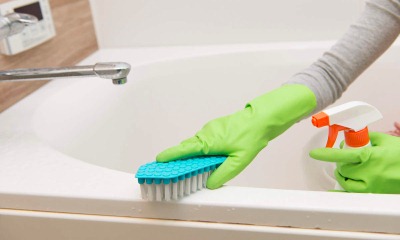 Baths are more resistant to mechanical damage, which can lead to rust, than cast iron.
Baths are more resistant to mechanical damage, which can lead to rust, than cast iron.
They do not tolerate high temperatures. Do not wash the steel bowl with hot water, this will lead to cracking of the enamel.
The choice of means for removing plaque from such a product is quite wide: from cleaning and whitening agents to concentrated gels and solutions. Prerequisite: in tandem with a soft foam sponge.
Cast iron
Cast iron baths are durable, resistant, do not corrode and retain heat perfectly.
To keep the enamel finish clean just enough regular detergent and a soft sponge after each use... If a plaque has nevertheless formed, both powdered products and liquids containing chlorine, alkali and weak acids can be used for removal.
Tile cleaning
The tiles in the bathroom are constantly exposed to high temperatures and high humidity, so plaque forms on them. The use of household chemicals with an aggressive composition only aggravates the situation - the surface dulls and loses its original shine.
In order not to be mistaken with the choice of detergent, you need to pay attention to the material from which the tiles are made:
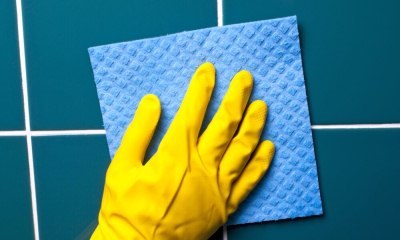 The ceramic has a smooth surface and is easy to clean. The simplest way: dilute 100 g of citric acid in a glass of water, apply to the surface with a spray bottle, rinse with clean water after drying.
The ceramic has a smooth surface and is easy to clean. The simplest way: dilute 100 g of citric acid in a glass of water, apply to the surface with a spray bottle, rinse with clean water after drying.- The glass coating is also easy to maintain, the best result is given by an industrial product for glass surfaces based on ammonia. The liquid must be sprayed onto the surface, after 5 minutes, rinse and wipe dry.
- Acrylic is a capricious material. Professional products are recommended for him. Acrylane by Bagi, a foam product that cleans tiles even without sponge. It must be applied to the surface, then rinsed thoroughly with clean water.
To prevent the formation of limescale on the tiles, it is enough to wipe the tiles dry each time after taking a bath.
We fight old deposits
It will not be possible to completely remove a thick layer of lime deposits with gentle means; you will have to resort to using aggressive components.
A mixture prepared according to the following recipe works effectively:
- add a little water to the cleaning powder, stir until gruel forms;
- add 1 tbsp. l "Whiteness", 2 tbsp. l vinegar (9% solution);
- apply the product to the affected areas with a spatula;
- leave for 15-20 minutes, as soon as the plaque begins to disintegrate, proceed to the next stage;
- sponge the surface;
- thoroughly rinse off the product with destroyed plaque;
- remove moisture with a dry cloth.
What is not recommended by manufacturers?
Application for acrylic bath products:
 Powdery and abrasive. Microdamages remain on the surface, due to which, over time, the surface will become dull and take on a gray tint.
Powdery and abrasive. Microdamages remain on the surface, due to which, over time, the surface will become dull and take on a gray tint.- Chlorine. The bath bowl becomes cloudy, the structure of the coating is damaged, it becomes porous.
- With acetone, solvent, ammonia. They destroy the surface, the bath loses its shine, darkens.
For the same reasons, prolonged contact with chlorine, gasoline, alcohol is contraindicated for acrylic products.
For steel and cast iron products covered with enamel, there are restrictions:
- The use of products containing strong acids (sulfuric, hydrochloric, oxalic, and so on).
- Prolonged contact with chlorine-containing solutions.
- Use of metal, hard brushes and washcloths.
All of the above can damage the protective layer of enamel or destroy its structure. This will affect the appearance of the bowl and intensify the process of deposition of dirt and plaque on the surface.
Housewives tips
Industrial solution "Whiteness" is popular among housewives, it effectively bleaches surfaces, disinfects and does not cause significant damage to the budget.
A liquid based on sodium hypochlorite (chlorine) is not contraindicated for processing enamel surfaces in a diluted form. For cast iron products, the ratio of "Whiteness" and water should be 1: 2, for steel - 1: 3.
It is necessary to fill the bowl with water (temperature 25-30 degrees), add 2 bottles of "Whiteness", after 15 minutes drain the water and thoroughly rinse the surface.
It is not recommended to use a product for acrylic baths, in order to avoid restoration or complete replacement of the bowl.
All the most important and useful information about bathroom cleaning is collected in this section of the site.
Conclusion
You can defeat lime deposits on the surface of a bathtub made of any material using household chemicals or homemade solutions.
In order not to harm the product and your own health, you must comply with safety measures, manufacturer's recommendations and avoid prolonged interaction of active components with the surface. Important to remember, plaque formation is easy to prevent, it is much more difficult to clean.

